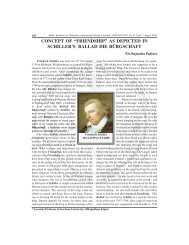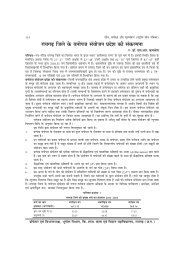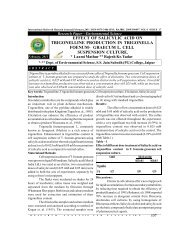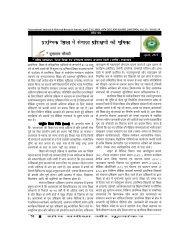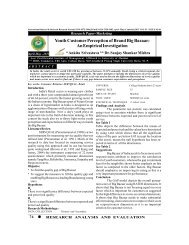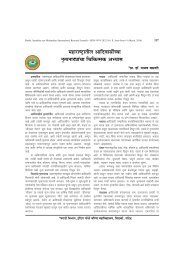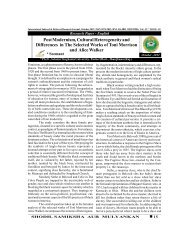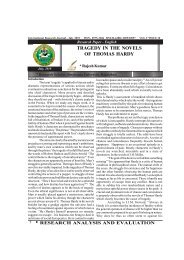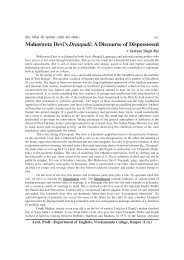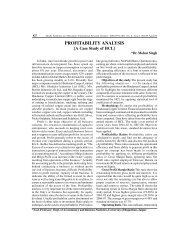Nanu July 2010 New 2010f.pmd - international indexed refereed ...
Nanu July 2010 New 2010f.pmd - international indexed refereed ...
Nanu July 2010 New 2010f.pmd - international indexed refereed ...
You also want an ePaper? Increase the reach of your titles
YUMPU automatically turns print PDFs into web optimized ePapers that Google loves.
International Research Journal , <strong>July</strong> <strong>2010</strong> ISSN- 0975-3486 RNI: RAJBIL 2009/30097 VOL I *ISSUE 10<br />
<strong>July</strong>, <strong>2010</strong><br />
A B S T R A C T<br />
Research Paper- Swasthavritta -Ayurved<br />
A COMPARATIVE STUDY OF<br />
KESHYAKALPAYOGA & SARVANGASAN<br />
IN THE MANAGEMENT OF ALOPECIA<br />
* Dr. Pawan Sharma<br />
* Deptt. * Assicate of Swasthavritta, Prof. Comm.Dept. Akhandanand, Sant Gadge Govt. Ayurved Maharaj College, Mahavidyalaya, Ahamdabad Walgaom.<br />
123456789012345678901234567890121234567890123456789012345678901212345678901234567890123456789012123456789012345678901234567890121<br />
123456789012345678901234567890121234567890123456789012345678901212345678901234567890123456789012123456789012345678901234567890121<br />
123456789012345678901234567890121234567890123456789012345678901212345678901234567890123456789012123456789012345678901234567890121<br />
123456789012345678901234567890121234567890123456789012345678901212345678901234567890123456789012123456789012345678901234567890121<br />
123456789012345678901234567890121234567890123456789012345678901212345678901234567890123456789012123456789012345678901234567890121<br />
123456789012345678901234567890121234567890123456789012345678901212345678901234567890123456789012123456789012345678901234567890121<br />
123456789012345678901234567890121234567890123456789012345678901212345678901234567890123456789012123456789012345678901234567890121<br />
123456789012345678901234567890121234567890123456789012345678901212345678901234567890123456789012123456789012345678901234567890121<br />
Now a days due to change of life style, Genetics reason and other many factors Baldness problem is<br />
increasing in both male and female. The medical term of baldness is alopecia, any type of hair loss is called<br />
alopecia. To get result in alopecia, I did work in kaishya kalpa (Kalpit yoga) or sarvangasan for two<br />
month.The content of kaishya kalp, Bhringrai, Patola patra and yastimadu. In Ayurved these drugs are<br />
mentioned as “Kashya” which means promote of hairs. Sarvangasan increase Blood flow towards the<br />
brain so by that function of lepa and sarvangasan I hope to get results.<br />
Key wards :- Khalitya roga, kaishya kalpa (Kalpita yoga) sarvangasan.<br />
Introduction<br />
loss is the term that the common man on the street will<br />
In the present Era due to the change in the life style and use to refer to any form of alopecia. Alopecia, on the<br />
routine work, man is not following the rule of Swasthvritta<br />
other hand, is the medical term used by doctors to refer<br />
(hygiene) &”Sadvaritta’(moral conduct). As the to hair loss.<br />
result of this he is suffering from various diseases. Factors that are involved in hair loss includes :<br />
Badness is a curse to mankind it is independent disease • Mithya Ahara Vihara • Mental causes<br />
as well associated with other diseases In these khalitya • Pathological diseases and medicines. • Genetics<br />
& palitya are most common. Though it doesnott affect Pathophysiology:<br />
the physical factor & it is not a infectious disease. but Total hairs in sclap about 100000. The scalp has a 3<br />
due to the hair fall man does not look beautiful. The man phase cycle of hair with almost 90 % of hair in the<br />
is a social person and due to this problem he feels anagen or growth phase (which may 2-6 layer), 1% in<br />
inferiority complex. As the result of inferiority complex the catagen phase (which may lost 3 weeks), and 10%<br />
his working power and ambitions decreases. He becomes in the telogen or resting phase (which may last three<br />
to suffer the mental tension. So we can not say ‘swastha’ month) This ratio is usually uniformly distributed over<br />
or healthy person to him because in Ayurveda a swasth the entire scalp. When hairs goes into the telogen phase<br />
(Healthy person) has these qualities)<br />
about 15-30% In this condition hairs falls rapidly and if<br />
^izlUukRefUnz;euk% LoLFkbR;fHk/kh;rs^<br />
this condition is not controlled then result of alopecia.<br />
The healthy hair not only give the man beauty but also Types of Alopecia :<br />
indicate his Yovan (Younger stage) The hair falling is A gradual thinking of the hair is natural in both men and<br />
said. Khalitya Indralupta & ‘Rugya’ by Ayurvedic women with aging. The hairs follicles go into a telogenic<br />
Acharya. In the modern science we say the alopecia or or resting stage. The remaining hairs become shorts<br />
bladness.<br />
and fewer in numbers.<br />
Aims & object<br />
• Alopecia Areata (AA) : Used to describe hair loss<br />
Review of Ayurvedic & Modern text. A comparative occurring in patches anywhere on the body. • Alopecia<br />
study of Kaishya Kalp & Sarvagasan in the Khalitya Totalis (AT) : Total loss of the hair on the scalp. •<br />
Disease. Many Resarches have been done in the context Alopecia Universalis (AU): Total loss of all hair on the<br />
of khalitya. It is more specific from them due to the body. • Alopecia Barbae : Loss of facial hair (for a man)<br />
comparative study of medicine (Keshyakalpa ) & especially in the beard area.• Alopecia Mucinosa :A<br />
‘Sarvangasan’ The aim of Researcher is to popularised type of alopecia which results in scaley patches. •<br />
vishist yoga in practice.<br />
Andorogenetic Alopecia (AGA) : Also known as male<br />
Alopecia : Any type of hair loss<br />
pattern baldness. It is a thinning of the hair to an almost<br />
Alopecia and hair loss are basically the same thing hair transparent state, in both men of women, it is thought<br />
15<br />
RESEARCH ANALYSIS AND EVALUATION
International Research Journal , <strong>July</strong> <strong>2010</strong> ISSN- 0975-3486 RNI: RAJBIL 2009/30097 VOL I *ISSUE 10<br />
to be a hereditary form of hair loss.<br />
• Traction Alopecia : Traction alopecia is usually due<br />
to excessive pulling or tension on hair shafts as a result<br />
of certain hairstyles. It is seen more often in women,<br />
particularly those of East Indian and Afro-Caribbean<br />
origin. Hair loss depends on the way the hair is being<br />
pulled. Prolonged traction alopecia can stop new hair<br />
follicles developing and lead to permanent hair loss.<br />
• Anagen Effluvium : This hair loss is generally caused<br />
by chemicals such as those used to treat cancer. Initially<br />
it causes patchy hair loss, which often then becomes<br />
total hair loss. The good news is that when you stop<br />
using these chemicals the hair normally grows back<br />
(usually about 6 months later). Other drugs also can<br />
cause hair loss. Many medicines used to treat even<br />
common diseases can causes hair loss. • Scarring<br />
Alopecia : A form of alpecia which leaves scarring on<br />
the area of hair loss. • Telogen Effluvium : A form of hair<br />
loss where more than normal amounts of hairs fall out.<br />
There is a general ‘thinning’ of the hair; unlike some<br />
other hairs and scalp conditions. It is temporary and the<br />
hair growth usually recover.<br />
Contents of the Trial therapy:<br />
All medicines ingrade and made into powder and used<br />
by lape externally.<br />
a) Keshya kalp yoga :<br />
Bhringraj:<br />
Hk`³~xj dVqdLrh{.kks :{kks”.k% dQokruqr~A<br />
ds’;LRoP;% d`feLokLkdkl’kksFkkeik.Mquqr~AA<br />
(Bhav Prakash)<br />
Patola Patra :<br />
jlfrDr iVksYL; i=kda rf}ysiukr~A<br />
bUnzyqIra bke;fr f=fHkjSo fnuS/kzoqe~AA (Sharander)<br />
Yasti madhu :<br />
;"Vh fgek xq:% Lok)h p{kq";k cyo.kZd`r%A<br />
lqfLuX/kk 'k`Øyk ds';k Lo;kZ fiÙkfuykl`ftr~ AA (Bhav<br />
Prakash)<br />
b) Sarvangasan :<br />
after sookshome vyayam Sarvangasan is done for 2-5<br />
minute.<br />
Mechanism : Lie down flat on the back. Keep the heels<br />
and toes together and stretched. Keep the hands straight<br />
by sides alongwith the body. Palms may face the ground.<br />
Start inhaling and raise the legs slowely upwars to 30<br />
degrees, then 60 degrees and then to 90 degrees angle.<br />
Exhaling and pressing the palms on the ground take the<br />
legs beyond the head and parallel to the ground. The<br />
knees in this position should not bend. Normalise the<br />
breath. With elbows resting on the ground, support the<br />
back with the hands and bring back the legs upwards<br />
and stretch them towards the sky. The whole body<br />
should stand straight on the shoulders and the chin<br />
16<br />
should touch the chest. Relax the toes and remain in this<br />
position as per the capacity and comfortably possible.<br />
Breathe in a normal way. Now exhaling, take the legs<br />
again beyond the head and parallel to the ground.<br />
Remove the support of the hands from the back and<br />
place the hands on the ground. Inhaling bring the back<br />
to the ground slowly touching each vertebra of the<br />
spine on the ground. Thereafter bring down the legs<br />
slowly and gently on the ground. Relax in Shavasan.<br />
Advantage : The principal benefit of sarvangasan is felt<br />
in the improved functioning of brain, nervous system,<br />
ductless gland respiratory system, blood circulation,<br />
throat abdomen and prompting our physical health and<br />
charm due to supply of blood in all the organs, all the<br />
cells are activated. Skin gains in beauty. As the blood<br />
flows into the roots of the hair, this prevents grayness<br />
and the fall of hair.<br />
Observation:<br />
Selection of patients and criteria of assessment : 30<br />
patients from NIA OPD, IPD and yoga unit were taken<br />
Group- A 10 Patients External use of lepa<br />
Group - B 10 Patients Sarvangasana<br />
Group -C 10 Patients External use of lepa +<br />
Sarvangasana<br />
Including criteria<br />
Age - 15 to 50 yrs. 3 Month - 8 to 5 yrs. of known disease<br />
Complete loss of hairs & dandruff were taken into<br />
consideration. Patients whose hair falls on touching,<br />
never comes again are taken into consideration.<br />
Exclusion criteria :<br />
Old age & hereditary baldness<br />
Disease chronic i.e. more then 5 yrs.<br />
Assessment criteria<br />
Following symptoms are taken & graded<br />
Hair falling<br />
Mild, Moderate, Severe<br />
+ ++ +++<br />
Rough hairs ,Weak hair root ,Seborrhea ,Hair warms<br />
Dandruff , Loss of hairs<br />
Result<br />
After using the drug, statistically & symptomatically<br />
results are -<br />
Discussion<br />
Fundamentaly Acharya Sushrut classified Baldness<br />
into vata, Pita, Kapha and Rakta. Kalpit keshya kalp<br />
yoga consists Bhringraj, Patal Patra, Yasti Madhul, Bhav<br />
Prakash and Raj Nighantu stated Bhringraj as kesya,<br />
Kesya ranjan. Sharangdhara stated patol patra as<br />
destroyes of indralupta. Bhav Prakash has mentioned<br />
yastimadhu as kesya. these are regarded as “Kesya”.<br />
Sarvangasan affects C.V.S., N.S. Thyroid gland.<br />
Sarvangasan increase flow of blood in brain. Which is<br />
nutrient for brain and hair. Due to this prevent hair<br />
falling and grayness of hairs, and promote growth of<br />
fjlpZ ,ukfyfll ,.M boSY;q,’ku
International Research Journal , <strong>July</strong> <strong>2010</strong> ISSN- 0975-3486 RNI: RAJBIL 2009/30097 VOL I *ISSUE 10<br />
B y K a lp it K e sh y a ka lp a<br />
( A )<br />
B y S a r v a ng a sa n a<br />
(B )<br />
B y ka lp it le p a &<br />
S a r v a ng a sa n a<br />
(C )<br />
S .<br />
N o<br />
S y m p to m s B e n e fi ts 't '<br />
va lu e<br />
p va lu e B e n e f its 't'<br />
v a lu e<br />
p<br />
va lu e<br />
B e ne f its<br />
't'<br />
v a lue<br />
p v a lu e<br />
1 H ai r fa ll in g 5 2 2 .2 = 0 .2 4 6 3 .6 9 = 0 .0 1 5 8 .5 4 .4 9 = 0 .0 0 1<br />
2 R o u g h h a ir 2 0 1 .0 = 0 .1 0 0 0 .0 0 0 .0 0 2 8 .5 1 .5 0 = 0 .1<br />
3 W ea k h ai r<br />
ro o t<br />
4 5 3 .2 = .0 1 4 2 2 .5 8 = 0 .0 5 5 8 .3 5 2 6 = 0 .0 0 1<br />
4 S eb o rrh o e a 3 3 1 .0 = .1 0 0 0 .0 0 0 .0 0 4 0 1 .5 0 4 = 0 .1<br />
5 H ai r w o rm 3 3 1 .0 = .1 0 0 0 .0 0 0 .0 0 3 3 .3 1 0 0 = 0 .1<br />
6 D an d ru ff 6 0 .8 6 5 .1 8 = .0 0 1 1 0 .5 3 .5 7 = 0 .0 1 6 0 3 .3 4 = 0 .0 1<br />
7 L o s s o f h a ir 2 3 2 .7 5 = .0 5 1 2 3 .2 8 = 0 .0 1 3 3 .3 3 .6 8 = 0 .0 1<br />
new hairs. Use of’Lepa” in a patients in group A Use of<br />
sarvangasan in 10 patients in Group-B Use of both lepa<br />
and sarvangusan in Group-C for a112 months<br />
All patients Sex, Age, Religion etc According to see<br />
getting results are like these. A/c to age the maximum<br />
no of patient’s age of 21-30 yrs i.e. 73.33%<br />
A/c to sex the maximum number of patients are male i.e.<br />
98.3% The disease is less in frequent in females A/c to<br />
marital status 63.3% are unmarried A/c to educational<br />
background, educated persons are more suffering from<br />
the disease this proves that people doing mental work<br />
are much more affected by the disease. A/c to diet the<br />
maximum patients of khalitya are of vegetarians i.e.<br />
76.66% after observation the habitate it is more observed<br />
in rural people i.e. 66.66% while observing the prakriti<br />
pitta prakriti 48.3%, Vatta prakriti 40% and kapaj 16.16%<br />
is seen affecting this disease. In Ayurved also vataj and<br />
pittaj prakriti patients are seen affecting with the disease<br />
RESEARCH ANALYSIS AND EVALUATION<br />
seeing the economic status, people with middle class<br />
group are more affected with the disease.<br />
Conclusion : All the above data shows that in khalitya,<br />
sarvangasan and kalpit keshya yoga is useful up to<br />
some extent only. All the groups are combined and<br />
according 10 symptoms benefits like that on hair falling<br />
52.5%, in weak hair root 45.2% an dandruff 45% an<br />
rough hair 26.6%, an seborrhea 30%, an hair worms<br />
25.5% and in loss of hair 19.23% so it is proved that in<br />
max. symptoms no can get so much goot benefits.Present<br />
research work is done on limited patients in limited time<br />
and limited sources but 10 limitation of time perhaps<br />
good results can not get.Perhaps then hat yogapradipika<br />
has given a references. of six month about sirshashan<br />
ofyra ifyra pSo "k.eklks/oZ u n`";rsA<br />
It is my opinion that this work be done with more patients,<br />
time and sources to see the efficacy or medicines and<br />
yoga.<br />
R E F E R E N C E<br />
• Natural therapy and yoga by Dr. Nagendra Niraj • Principle of anatomy and physiology - Tortara • Histology of normal<br />
hair - Churchil living stone • Article Embryology and anatomy of the hair follicle, M.C. Graw hill • Yoga and Ayurveda by<br />
Rajkumar jain • ‘Yoga sutra by Patanjali • Bhav Prakash Nighantu- Shree Chunekar evam Gangasay pandey • Drava guna vigyan<br />
- Priyavath sharma • Raj NIghantu -Indradev Tripathi • ‘Nigantu Adarsh - Bapalal Vedna • Indian medicinal plant- Kirtikar<br />
& S. Basu.<br />
17



